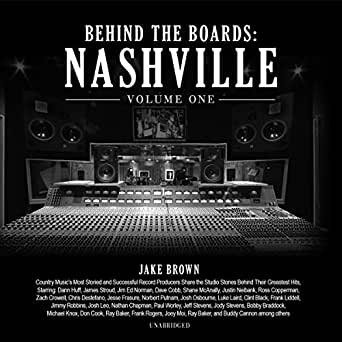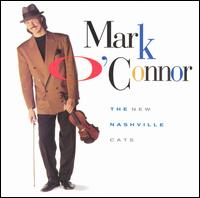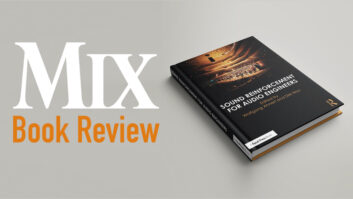 BOOK REVIEW
BOOK REVIEW
BEHIND THE BOARDS: NASHVILLE by Jake Brown
(Music Square Media/Baker & Taylor, 2020)
Give Jake Brown credit for the passion he brings to his subject. In this case, the author of some 50 books on various aspects of music making (including three volumes of Nashville Songwriter profiles and two volumes of Behind the Boards titles devoted to rock producers) focuses on Nashville producers—always an interesting subject with a rich history going back to Nashville Sound visionaries Owen Bradley, Chet Atkins and Billy Sherrill. It comes to a tune of 595 pages of profiles almost evenly divided between contemporary young lions and veterans who paved the way for them, and who in turn succeeded the above-named pioneers whose work made Nashville’s Music Row the epicenter of great country music, as well as a leader in embracing innovations in studio technology and design.
So why isn’t Behind the Boards: Nashville the essential volume it should be rather than a wearisome slog through sloppy research, bad writing and maddening stylistic weirdness? Well, the answers are threefold: (1) the research is breathtakingly sloppy, especially considering it requires but a few seconds on Wikipedia or artist websites to check a name’s proper spelling (what possibly could be the excuse for identifying Emmylou Harris as Emmy Lou Harris; or Steve Earle as Steve Earl; or the highly regarded but unfortunately deceased engineer Lynn Peterzell as Lynn Peter Zell?); (2) so many, too many to count, ungainly sentences are the norm rather than the exception, such as this from the Don Cook entry–Years later, when Cook’s inextricable link with Brooks & Dunn began, vs. what would have been the dream position for any producer looking to build a sound from the ground up, ironically Don revealed he was an exception to that rule when the job was first offered to him—thus begging the questions: what’s with the ubiquitous use of “vs.” throughout the book, and was an editor involved at all in this project?; (3) the author, perhaps in thrall of Trump tweets, insists throughout on bizarre, nonsensical capitalizations: herewith from the James Stroud chapter, in a section on Stroud’s work with Willie Nelson—stay with me now: “The first music they recorded together came not in a studio but on a much more pressured stage as far as auditions LIVE on NATIONAL TELEVISION! The caliber of gig reserved only for the JEDI KNIGHTS of sound recording, Stroud followed in the proud tradition of fellow legend Bones Howe…”). James Stroud is a good man who deserved better. May the Force be with him.
About the time you’re thinking there is still some interesting inside info here about gear and unusual approaches to recording (the Dan Huff, Ross Cooperman and Nathan Chapman chapters in particular), something crops up so outrageously inaccurate you begin to question everything else you have read or will read. Consider Tony Brown discussing his award winning work with Vince Gill on 1992’s multi-platinum, much-honored I Still Believe in You album.
 The author describes a “project” song Gill brought in, still unfinished, titled “Reckless,” so impressive Tony decided it should be recorded right away “and you can finish the second verse later, sing the first verse twice.” CBS News, we are told, extolled the finished cut as “special because it was a collaboration with Ricky Skaggs and Steve Wariner.” In fact, I Still Believe in You contains neither a song titled “Reckless” nor a Gill-Wariner-Skaggs collaboration. However, one of two Grammy winning performances on Mark O’Connor’s The New Nashville Cats, a ‘91 album featuring O’Connor and a band of next-generation studio stalwarts, features Gill, Wariner and Skaggs going to town on “Restless,” a hard-driving number originally written and recorded in 1968 for Columbia by the Original Cat, Carl Perkins. The Perkins version happens to feature dazzling guitar solos that Carl considered as good as any he, one of the architects of rock ‘n’ roll guitar, ever laid down in the studio, as Carl himself told me during interviews I conducted with him for his official biography, Go, Cat, Go! The Life and Times of Carl Perkins, The King of Rockabilly (Hyperion, 1996). How all this became “Reckless,” a Vince Gill composition written and recorded for I Still Believe in You a year after “Restless” was introduced on O’Connor’s album, one can only guess.
The author describes a “project” song Gill brought in, still unfinished, titled “Reckless,” so impressive Tony decided it should be recorded right away “and you can finish the second verse later, sing the first verse twice.” CBS News, we are told, extolled the finished cut as “special because it was a collaboration with Ricky Skaggs and Steve Wariner.” In fact, I Still Believe in You contains neither a song titled “Reckless” nor a Gill-Wariner-Skaggs collaboration. However, one of two Grammy winning performances on Mark O’Connor’s The New Nashville Cats, a ‘91 album featuring O’Connor and a band of next-generation studio stalwarts, features Gill, Wariner and Skaggs going to town on “Restless,” a hard-driving number originally written and recorded in 1968 for Columbia by the Original Cat, Carl Perkins. The Perkins version happens to feature dazzling guitar solos that Carl considered as good as any he, one of the architects of rock ‘n’ roll guitar, ever laid down in the studio, as Carl himself told me during interviews I conducted with him for his official biography, Go, Cat, Go! The Life and Times of Carl Perkins, The King of Rockabilly (Hyperion, 1996). How all this became “Reckless,” a Vince Gill composition written and recorded for I Still Believe in You a year after “Restless” was introduced on O’Connor’s album, one can only guess.
So approach all claims cautiously. That studio titans such as Paul Worley, Jim Ed Norman, Tony Brown, Buddy Cannon and especially Norbert Putnam (whose amazing career spans the ‘60s to the present day and includes work with Elvis, Dylan and Cash in addition to the founding of Quad Studios) are included along with the younger “track guys” (producers who create entire bands by themselves on record rather than using session players) offers a balance of perspectives honed and refined from the ‘80s to the present day; nevertheless, don’t be surprised if at the end you’re in despair. Merle, we hardly knew ye.







